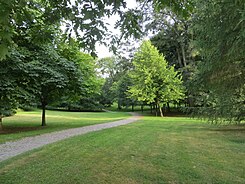Christiansenpark
| Christiansenpark | |
|---|---|
| Park in Flensburg | |

|
|
| Basic data | |
| place | Flensburg |
| District | West elevation |
| Created | circa 1797 |
| Surrounding streets | Mühlenstraße (Møllegade) , Stuhrsallee (Stuhrs Allé) |
| Buildings | Ice Age house , mummy grotto , pavilion, three ponds, resting places |
| use | |
| User groups | Pedestrians , leisure |
| Technical specifications | |
| Parking area | approx. 42,000 m² |
The Christiansen Park is a park in the city of Flensburg , in the district of Western height . It is close to the old cemetery , the city park and the Museumberg , to whose complex it belongs today. Christiansenpark is the second largest park in the city, after the Volkspark near Mürwik .
history
In 1797 the merchant Peter Clausen Stuhr laid out a large garden west of the area of the old cemetery, which at that time did not exist. Stuhrs Garten was separated from this area by an avenue, which has been called Stuhrsallee since around 1803. At some point during this time, Andreas Christiansen senior laid out another garden to the east of the area of the later cemetery (where the Museum Mountain is today), which is now called Museum Mountain Park . The cemetery was inaugurated in 1813. In 1820, Andreas Christiansen junior merged the Christiansen garden with Stuhr's garden to form a large park. This is how Christiansenpark was created. The cemetery was integrated into this park. During that time, the park expanded to an area of around 250,000 m². Directly below the park was the Christiansen Palace , which was also built by Andreas Christiansen senior on the Holm No. 12 property and was apparently connected to the above park. After the economic decline of the Christiansen family in the 1850s, the park fell into several parts. The western part was taken over in 1856 by the landowner Fromm, the eastern part in 1866 by the city's second mayor , Wilhelm Funke. In the following years, large parts of the park were built over. In 1992 the western remainder of Christiansenpark, basically Stuhrs Garten, was acquired by the city of Flensburg and opened to the public. The park area of 4.2 hectares has remained from the formerly 25 hectare park.
Furnishing
The park's attractions include plantings, the mummy grotto , the Ice Age house , a pavilion and three ponds.
Web links
Individual evidence
- ↑ Active pensioners, torsdagsholdet (Ed.): Flensborgs gadenavne . Flensburg 1995, p. 18 .
- ↑ Active pensioners, torsdagsholdet (Ed.): Flensborgs gadenavne . Flensburg 1995, p. 21 .
- ^ A b c d Christiansenpark, Förderkreis Christiansenpark eV, history of the park ; Retrieved on: July 8, 2014
- ↑ a b Flensburg street names . Society for Flensburg City History, Flensburg 2005, ISBN 3-925856-50-1 , article: Stuhrsallee
- ↑ a b c d e f Andreas Oeding, Broder Schwensen, Michael Sturm: Flexikon. 725 aha experiences from Flensburg !. Flensburg 2009, article: Christiansenpark
- ↑ See Christiansenpark, Förderkreis Christiansenpark eV, history of the park ; Retrieved on: July 8, 2014
- ↑ See Andreas Oeding, Broder Schwensen, Michael Sturm: Flexikon. 725 aha experiences from Flensburg !. Flensburg 2009, article: Christiansenpark
- ^ Flensburg - history of a border town. Edited by the Society for Flensburg City History. Flensburg 1966, pages 225 and 543 ff.
- ^ Writings of the Society for Flensburg City History (ed.): Flensburg in history and present . Flensburg 1972, page 429
- ↑ Flensburg. Leisure offers. Christiansenpark , accessed on: November 10, 2019